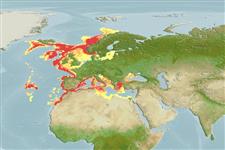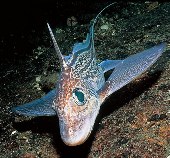Masukkan pemerhatian anda di Fish Watcher
| Native range | All suitable habitat | Point map | Year 2050 |

|
| This map was computer-generated and has not yet been reviewed. |
| Chimaera monstrosa AquaMaps Data sources: GBIF OBIS |
muatnaik fotos/gambar dan video
Pictures | Videos | imej GoogleChimaera monstrosa
Picture by Svensen, E.
Pictures | Videos | imej GoogleChimaera monstrosa
Picture by Svensen, E.
Spain country information
Common names:
Borrico, Escopeta, Gata moixa
Occurrence: native
Salinity: marine
Abundance: | Ref:
Importance: | Ref:
Aquaculture: | Ref:
Regulations: | Ref:
Uses: no uses
Comments: Found in Galicia (Ref. 86578).
National Checklist:
Country Information: https://www.cia.gov/library/publications/resources/the-world-factbook/geos/sp.html
National Fisheries Authority:
Occurrences: Occurrences Point map
Main Ref: Muus, B. and P. Dahlström, 1978
National Database: ICTIMED
Occurrence: native
Salinity: marine
Abundance: | Ref:
Importance: | Ref:
Aquaculture: | Ref:
Regulations: | Ref:
Uses: no uses
Comments: Found in Galicia (Ref. 86578).
National Checklist:
Country Information: https://www.cia.gov/library/publications/resources/the-world-factbook/geos/sp.html
National Fisheries Authority:
Occurrences: Occurrences Point map
Main Ref: Muus, B. and P. Dahlström, 1978
National Database: ICTIMED
Common names from other countries
klasifikasi / Names Nama-nama umum | Sinonim (persamaan) | Catalog of Fishes(Marga, Jenis) | ITIS | CoL | WoRMS | Cloffa
Holocephali (chimaeras) (chimaeras) > Chimaeriformes (Chimaeras) > Chimaeridae (Shortnose chimaeras or ratfishes)
Etymology: Chimaera: Named for the mythological creature composed of parts of multiple animals, referring to their odd mix of characteristics (See ETYFish); monstrosa: Latin for strange or grotesque, referring to its strange appearance, as if composed of parts of multiple animals (See ETYFish).
More on author: Linnaeus.
Etymology: Chimaera: Named for the mythological creature composed of parts of multiple animals, referring to their odd mix of characteristics (See ETYFish); monstrosa: Latin for strange or grotesque, referring to its strange appearance, as if composed of parts of multiple animals (See ETYFish).
More on author: Linnaeus.
Environment: milieu / climate zone / depth range / distribution range Ekologi
laut batidemersal; oceanodromus (Ref. 51243); kisaran kedalaman 40 - 1400 m (Ref. 104125), usually 300 - 500 m (Ref. 4443). Deep-water; 75°N - 27°N, 32°W - 35°E
Penyebaran Negara-negara | Daerah-daerah FAO | Ecosystems | Kemunculan | Point map | Introduksi | Faunafri
Eastern Atlantic: northern Norway and Iceland, Skagerrak and Kattegat south to Morocco including western Mediterranean (some isolated records from eastern part), Azores and Madeira Islands. Records from South Africa are questionable. Reported from Oshima, Japan (FMNH 89161) (Ref. 27954).
Length at first maturity / Size / Weight / umur
Maturity: Lm 45.9 range ? - ? cm
Max length : 150 cm TL jantan/; (Ref. 35388); Berat maksimum terpublikasi: 2.5 kg (Ref. 4645)
Max length : 150 cm TL jantan/; (Ref. 35388); Berat maksimum terpublikasi: 2.5 kg (Ref. 4645)
Bathydemersal to benthopelagic generally between 300 and 500 m depth. Found in the upper continental slope. Usually found in deeper waters in southern latitudes, while making a summer inshore migration up to 40-100 m in the northern areas. Sluggish, usually occurring in small groups. Feeds mainly on bottom-living invertebrates. The single dorsal spine is sharp and pointed, and although only mildly venomous can inflict a painful wound. Oviparous. Males have a clasper on the forehead that is probably used to hold on to the female during copulation. Egg capsules are about 17 cm long; young look alike adults and hatch when 10 cm long. Common by-catch when trawling for shrimps in the North Sea or Skaggerak.
Life cycle and mating behavior Kematangan | Reproduksi, perkembang biakan | Pemijahan | telur-telur | Fecundity | Larva
Oviparous; egg-capsules slender, club-shaped with narrow lateral membranes and a horny filament at the long pointed end, 17 cm long and 3 cm wide; deposited mainly in spring and summer. The embryos developing in about 9-12 months and hatch at 10 cm length.
rujukan utama
Upload your references | Acuan | Koordinator | mitra
Krefft, G., 1990. Chimaeridae. p. 111-113. In J.C. Quero, J.C. Hureau, C. Karrer, A. Post and L. Saldanha (eds.) Check-list of the fishes of the eastern tropical Atlantic (CLOFETA). JNICT, Lisbon; SEI, Paris; and UNESCO, Paris. Vol. 1. (Ref. 4443)
Status IUCN Red List (Ref. 130435: Version 2024-2)
Rentan, lihat daftar merah IUCN (VU) (A2bd); Date assessed: 02 September 2019
penggunaan manusia
Perikanan: nilai komersial kecil
FAO(Perikanan: production; publication : search) | FIRMS (Stock assessments) | FishSource | Sea Around Us
informasi lanjut
Population dynamics
Growth parameters
Max. ages / sizes
Length-weight rel.
Length-length rel.
ukuran frekuensi
Mass conversion
pemulihan
Kelimpahan
Growth parameters
Max. ages / sizes
Length-weight rel.
Length-length rel.
ukuran frekuensi
Mass conversion
pemulihan
Kelimpahan
Life cycle
Reproduksi, perkembang biakan
Kematangan
Fecundity
Pemijahan
Spawning aggregations
telur-telur
pekembangan telor
Larva
Dinamika larva
Reproduksi, perkembang biakan
Kematangan
Fecundity
Pemijahan
Spawning aggregations
telur-telur
pekembangan telor
Larva
Dinamika larva
Physiology
Body composition
Nutrients
Oxygen consumption
Swimming type
Swimming speed
Visual pigments
Fish sound
Diseases & Parasites
Toxicity (LC50s)
Body composition
Nutrients
Oxygen consumption
Swimming type
Swimming speed
Visual pigments
Fish sound
Diseases & Parasites
Toxicity (LC50s)
Human related
Aquaculture systems
profil budidaya air
Strain
Ciguatera cases
Stamps, coins, misc.
Aquaculture systems
profil budidaya air
Strain
Ciguatera cases
Stamps, coins, misc.
Alat, peralatan
Bio-Quiz | E-book | Penuntun lapangan | tanda freqkuenci panjang | peringkat sejarah hidup | peta titik | Classification Tree
| Catch-MSY |
laporan khas
muat turun XML
Sumber internet
Aquatic Commons | BHL | Cloffa | BOLDSystems | Websites from users | semak peneliti ikan | CISTI | Catalog of Fishes(Marga, Jenis) | DiscoverLife | ECOTOX | Faunafri | Fishtrace | GenBank(genom, Nukleotida) | GloBI | GOBASE | | Google Books | Google Scholar | Google | IGFA World Record | MitoFish | Pangkalan data nasional | Otolith Atlas of Taiwan Fishes | PubMed | Reef Life Survey | Scirus | SeaLifeBase | Tree of Life | Wikipedia(pergi, Cari) | World Records Freshwater Fishing | Zoobank | Zoological Record
Estimates based on models
Preferred temperature (Ref. 115969): 3.7 - 14.1, mean 7.9 (based on 179 cells).
Phylogenetic diversity index (Ref. 82804): PD50 = 0.5000 [Uniqueness, from 0.5 = low to 2.0 = high].
Bayesian length-weight: a=0.00257 (0.00156 - 0.00424), b=3.01 (2.87 - 3.15), in cm Total Length, based on LWR estimates for this species & (Sub)family-body (Ref. 93245).
Trophic level (Ref. 69278): 3.5 ±0.0 se; based on diet studies.
Daya lenting (Ref. 120179): Rendah, Waktu penggandaan populasi minimum 4.5 - 14 tahun (Assuming Fec <100;).
Fishing Vulnerability (Ref. 59153): High to very high vulnerability (68 of 100).
Climate Vulnerability (Ref. 125649): Moderate vulnerability (38 of 100).




